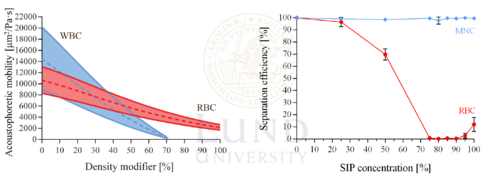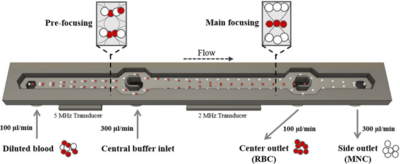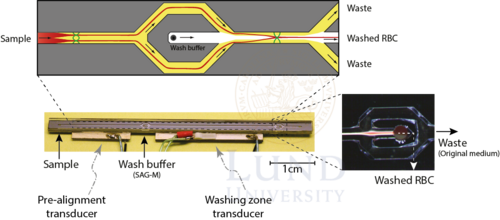RBC
Acoustic separation of red blood cells
Separation of red blood cells (RBC) from white is one of the most important separations done in medicine. Doing it acoustically poses a great challenge. Although white blood cells (WBC) are generally larger in size than red blood cells, the red cells are denser than the white resulting in the acoustic mobility of red and white cells to be very similar. The mobility of the cells depends on their physical properties compared to the medium they are suspended in, so by changing the medium properties it is also possible to affect the acoustic mobility.
A density modifier, Percoll, is added to an isotonic medium in which the cells are suspended in. In the left graph below, the mobility of RBCs and WBCs are shown in relation to the density modifier. At 70% added modifier, the mobility of WBCs are basically zero, while the RBCs still move in the sound field. Figure on the right show the separation efficiency of WBC/RBC in the side outlets in the chip shown further below.


Urbansky A., Ohlsson P., Lenshof A., Garofalo F., Scheding S. and T. Laurell, Rapid and effective enrichment of mononuclear cells from blood using acoustophoresis, Scientific Report, 2017, 7, 17161
Acoustophoresis in miniaturized system
The preparation of protein free RBC concentrate is important for blood transfusion to patients suffering with immunoglobulin A (IgA)-deficiency and antibodies against IgA. A miniaturized system for removing plasma proteins and other low-molecular-weight compounds from red blood cell concentrate in a simple one-step-process using integrated ultrasound is developed. It utilizes the principles of acoustophoresis to transfer the RBCs from the original plasma-containing solution into a protein-free SAG-M additive solution in a continuous flow process.
We show a nearly complete removal of both albumin and IgA from concentrated RBCs via this one-step-processes in samples obtained from RBC concentrate. The cell recovery of our technology is close to 97 %, compared to just above 90 % of the current procedure of repeated dilution and centrifugation steps. This work clearly shows the potential of integrated acoustophoresis in a miniaturized system for clinical applications.

References
Tenje M., Lundgren M. N., Swärd-Nilsson A-M., Kjeldsen-Kragh J., Åberg L. and A. Lenshof, Acoustophoretic removal of proteins from blood components, Biomedical Microdevices, 2015, 17:95
